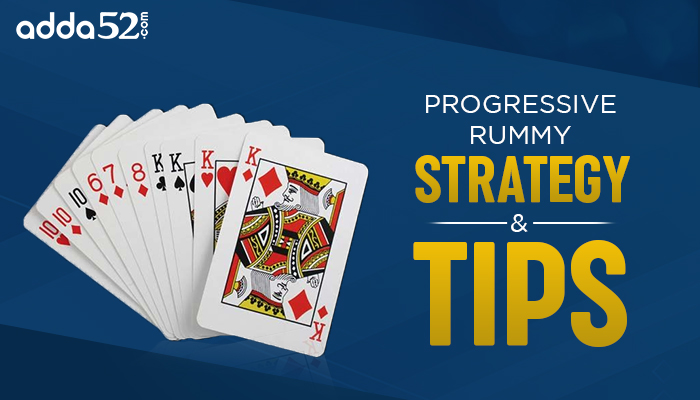Introduction
Online Progressive Rummy has charmed millions of people with its variations and twists. However, to become proficient or a winner in this rummy game you should make yourself familiar with the Progressive Rummy rules and strategy in a better way. In this blog, you can find the fundamental rules, strategies, and gameplay that will help you win the game and become a better player.
What is Progressive Rummy?
Progressive Rummy is a modified version of the classic meld-making card game, featuring small rule changes that distinguish it from the original. Despite these variations, the essential melds in the game align with traditional rummy, maintaining familiarity. It offers a unique and engaging experience for 2-8 players with two or three decks. The game involves drawing and discarding cards clockwise until a player successfully melds the cards with the minimum score, adding a strategic twist to the traditional rummy concept.
How to Play Progressive Rummy?
Learn the ins and outs of Progressive Rummy, a thrilling card game that evolves with each round. To get started, follow these instructions for setting up, playing, and mastering the game:
Setting Up the Game:
Add one deck for every two players in the game. For example, if 5 players are playing, use 3 decks. For 7 players, use 4 decks.
Goal of the Game:
The main goal is to create melds. Melds come in two types: sequences (cards in order) and sets (cards with the same rank).
Melds:
In Progressive Rummy, there are two types of melds: sequences and sets.
Playing Off Existing Melds:
Players can add cards to melds already on the board. For example, adding a King to a set of Kings or adding cards to the ends of a sequence.
Deal:
At the start of the game, the players determine the first dealer by drawing cards or making a voluntary choice. After choosing the dealer, reshuffle the deck and begin the deal.
Rounds:
In Progressive Rummy, each round has specific meld goals, and the rounds end when those goals are met.
Ending a Round:
A round concludes when a player fulfils the meld requirements for that round. If two players both play one set in Round 1, the round continues until one player plays two sets.
Penalty Points:
Having cards in hand at the end of a round results in penalty points, as in other Rummy variations.
Progressive Rummy Rules
Like any other card game, Progressive Rummy boasts a set of distinctive rules that add depth and excitement to the gameplay. Here are some important rules that a player must know:
- Progressive Rummy can be played by 2-8 players with either two or three decks
- Each player picks up a card from the deck, and the player who draws the lowest rank card acts as the dealer
- After dealing the cards, the remaining cards are placed face down to form the stockpile. A player, when required, discards a card and places it facing upside to form the discard pile
- The player to the left of the dealer draws a card from the stockpile and discards a card on the table that s/he thinks is irrelevant to the meld
- The practice of drawing and discarding cards moves clockwise until one of the players melds the card with a minimum score
- In the Progressive Rummy, there will be 7 deals. In the first deal, players get 6 cards to make two sets. In the second deal, they get 7 cards and have to make one set and one sequence. Players get 8 cards in the third deal and have to make two sequences. In the fourth deal, there will be 9 cards and 3 sets. The players in the 5, 6 and 7 deals will get 10, 11, and 12 cards respectively
- Players will have to make 2 sets and 1 sequence, 1 set and 2 sequences, and 3 sequences in the 5th, 6th, and 7th deal,
- A round will end when the player plays a specific number of specific melds in a particular round
- After a player finishes the round’s tasks, the round concludes, and a new one starts
Types of Melds
Players have to make two types of melds in a Progressive Rummy game:
Sequences
Like straights in poker, a sequence is a row of cards in ascending or descending order of the same suit.
Example: 7, 8, and 9 of Diamonds
Sets
Sets are groups of 3 cards with the same rank value.
Example: 9s of Spade, Diamond, and Club
The Deal
At the beginning of the game, players draw cards to decide the first dealer. Or if a player wants they can volunteer. Once the dealer is chosen, the cards are shuffled, and dealing starts.
The dealing starts in the clockwise direction, which means the player to the right of the dealer gets the first card, becoming the dealer for the next round.
For the initial round, each player gets 6 cards. Unlike Contract Rummy, Progressive Rummy changes the rules. In the second round, players get 7 cards, in the third round, 8 cards, and so on, up to the seventh round, where each player receives 12 cards.
The Rounds
In Progressive Rummy, each round has specific goals, and a round ends when a player completes those goals. Here’s a simple breakdown:
Round 1: Two sets
Round 2: One sequence, one set
Round 3: Two sequences
Round 4: Three sets
Round 5: Two sets, one sequence
Round 6: One set, two sequences
Round 7: Three sequences
A round only ends when one player meets the specific requirements for that round. If two players play one set each in Round 1, the round doesn’t end until one player plays two sets.
Once a player completes the goals for a round, a new round begins. Like other rummy variations, holding cards in your hand at the end of a round results in penalty points.
Scoring
In Progressive Rummy, your goal is to have the lowest score to win. You earn penalty points based on the value of the cards in your hand after each of the 7 rounds. The scores from all rounds are added up, and the player with the lowest total score is the winner.
Here is a scoring sheet for the assigned value for each card:
- Number Cards (2-10): Face value (e.g., a 5 of hearts is worth 5 points).
- Face Cards (Jack, Queen, King): 10 points each.
- Ace: 15 points.
- Joker: Usually, the Joker is worth 25 points.
Progressive Rummy Strategy
Strategy is very important to win the game in Progressive Rummy. One of the strategies for winning is to keep an eye on the cards your competitors are discarding. Always remember, jokers are the wild card, and you can place them easily to meld. Also, try to make other sets with the cards available to you.
Progressive Rummy vs. Traditional Rummy
Traditional rummy and Progressive Rummy share similarities in terms of the goal of creating melds, the types of melds, and playing off existing melds. However, there are notable differences, particularly in the setup, deal, rounds, and meld requirements.
- Game Setting: Traditional rummy typically involves a fixed number of decks, often two decks, regardless of the number of players. In contrast, Progressive Rummy adapts the number of decks based on the number of players, ensuring a proportional and dynamic game setup.
- Objective: Both games share the goal of creating melds, but Progressive Rummy introduces specific requirements for each round, adding a layer of complexity to the game.
- Types of Melds: While both games recognise sequences and sets, Progressive Rummy restricts the number of cards in a set, mandating exactly three cards for sets. Traditional Rummy typically allows sets of any size.
- Playing Off Existing Melds: Both games permit players to add cards to existing melds, promoting strategic gameplay. The similarity lies in expanding melds, whether sets or sequences.
- Deal: Traditional rummy typically involves a fixed number of cards dealt per player throughout the game. In Progressive Rummy, the number of cards dealt increases with each round, introducing a progressive element to the deal.
- Rounds: The concept of rounds exists in both games, but the specific meld requirements for each round distinguish Progressive Rummy. Traditional rummy does not typically have round-specific meld requirements.
- Ending a Round: While both games conclude a round when specific meld requirements are met, Progressive Rummy introduces the possibility of a continuation if multiple players fulfill the requirements simultaneously, adding an extra layer of competition.
- Penalty Points: Both games share the concept of penalty points for holding cards at the end of a round, aligning with the general principles of rummy variations.
Frequently Asked Questions
What are the rules for Progressive Rummy?
In Progressive Rummy, players draw and discard cards to form sets and sequences. Each round has a specific goal, and the game progresses with increasing difficulty.
How much is a Joker worth in Progressive Rummy?
A Joker holds a fixed value of 25 points in Progressive Rummy, contributing significantly to your total score.
Is an Ace high or low in Progressive Rummy?
In Progressive Rummy, an Ace is considered low. It holds a value of 1 point, making it the lowest-ranking card when forming sets and sequences.
Conclusion
In conclusion, Progressive Rummy offers a dynamic and strategic twist to the classic card game, requiring players to adapt their approach to each round’s specific meld goals. The game’s unique setup, progressive dealing, and round-specific requirements set it apart from traditional rummy, adding complexity and excitement. To succeed in Progressive Rummy, players must not only understand the rules but also employ a strategic approach, keeping a keen eye on opponents’ discards and leveraging the wild card potential of jokers. With its engaging gameplay, distinct rules, and scoring system favouring the lowest total score, Progressive Rummy provides a thrilling and evolving card-playing experience for 2-8 players.


